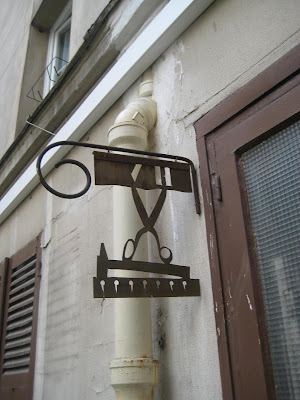 Alongside the lilac bushes and rusting bicycles of an unpolished Parisian courtyard is something much more surprising - a mysterious memorial plaque commemorating soldier victims of the First World War. Who put it here though and why?
Alongside the lilac bushes and rusting bicycles of an unpolished Parisian courtyard is something much more surprising - a mysterious memorial plaque commemorating soldier victims of the First World War. Who put it here though and why? The stretch of the Rue Saint Maur which cuts across the 10th arrondissement towards the Hopital Saint Louis is the domain of the worker. Apart from two or three solid Haussmannian properties, these are simple buildings with long, twisting courtyards spread out behind. The number 212 is a typical example.

 Walk through the Porte Cochère and you enter a pastoral picture-book scene of 19th century Paris (if you can overlook the parked cars!). Here wispy bushes of lilac and fig push up against the crumbling stone walls and glass verandas of small workshops. Outside, rusting signposts give clues to the trades of previous owners.
Walk through the Porte Cochère and you enter a pastoral picture-book scene of 19th century Paris (if you can overlook the parked cars!). Here wispy bushes of lilac and fig push up against the crumbling stone walls and glass verandas of small workshops. Outside, rusting signposts give clues to the trades of previous owners.
Although several of these are now used by photographers or architects, the banging and whirring sounds from others show that some of these units are still used for manufacturing. Others sit empty, awaiting renovation into edgy, urban office space or loft-style apartment units.

 The courtyard is dusty and decomposing, with an ivy-clad electricity substation to one side, but this is clearly an area undergoing gradual gentrification. How does it differ then from the place in 1914 that 25 men left and never returned to? Physically, the environment has not changed - the men could return today and still find their home or place of work. The changes have been more of a social nature, and it is surely the social balance at the time which helped to get the memorial plaque put in place.
The courtyard is dusty and decomposing, with an ivy-clad electricity substation to one side, but this is clearly an area undergoing gradual gentrification. How does it differ then from the place in 1914 that 25 men left and never returned to? Physically, the environment has not changed - the men could return today and still find their home or place of work. The changes have been more of a social nature, and it is surely the social balance at the time which helped to get the memorial plaque put in place.
 What is the message on the plaque? “Ce marbre a été érigé par souscription des locataires et amis sous le patronage des propriétaires” A clear difference here is made between the locataires (those renting) and the propriétaires (the owners). The suggestion therefore is that the men killed were primarily workers, either living here in rented properties or working in the manufacturing units in the courtyard, and that the property and workshop owners felt compelled to commemorate the heavy price that had been paid by their men during the conflict.
What is the message on the plaque? “Ce marbre a été érigé par souscription des locataires et amis sous le patronage des propriétaires” A clear difference here is made between the locataires (those renting) and the propriétaires (the owners). The suggestion therefore is that the men killed were primarily workers, either living here in rented properties or working in the manufacturing units in the courtyard, and that the property and workshop owners felt compelled to commemorate the heavy price that had been paid by their men during the conflict.
 What is not clear though is why this was done here and not elsewhere. Across Paris there must have been thousands of similar situations, but I have never seen such a plaque as this before. Does this suggest that here at least relations between the classes were exemplary? Regularly polished by the concierge who lives alongside, it remains in place today as an important reminder of sacrifices past. Perhaps she asks herself if such a monument would be put up here today.
What is not clear though is why this was done here and not elsewhere. Across Paris there must have been thousands of similar situations, but I have never seen such a plaque as this before. Does this suggest that here at least relations between the classes were exemplary? Regularly polished by the concierge who lives alongside, it remains in place today as an important reminder of sacrifices past. Perhaps she asks herself if such a monument would be put up here today.

 The message is typical Zoo Project - a painting of a wild animal with a warning against wild humans (Gare aux Hommes), but if the words are a little tired, the gorilla itself is fantastic. Just as a little reminder, the artist(s?) behind the label works in complete anonymity, at speed and with brushes and paint, so to give the creature a mischievous glint in the eye and a wry smile - especially at this size - is little short of miraculous.
The message is typical Zoo Project - a painting of a wild animal with a warning against wild humans (Gare aux Hommes), but if the words are a little tired, the gorilla itself is fantastic. Just as a little reminder, the artist(s?) behind the label works in complete anonymity, at speed and with brushes and paint, so to give the creature a mischievous glint in the eye and a wry smile - especially at this size - is little short of miraculous.





















































